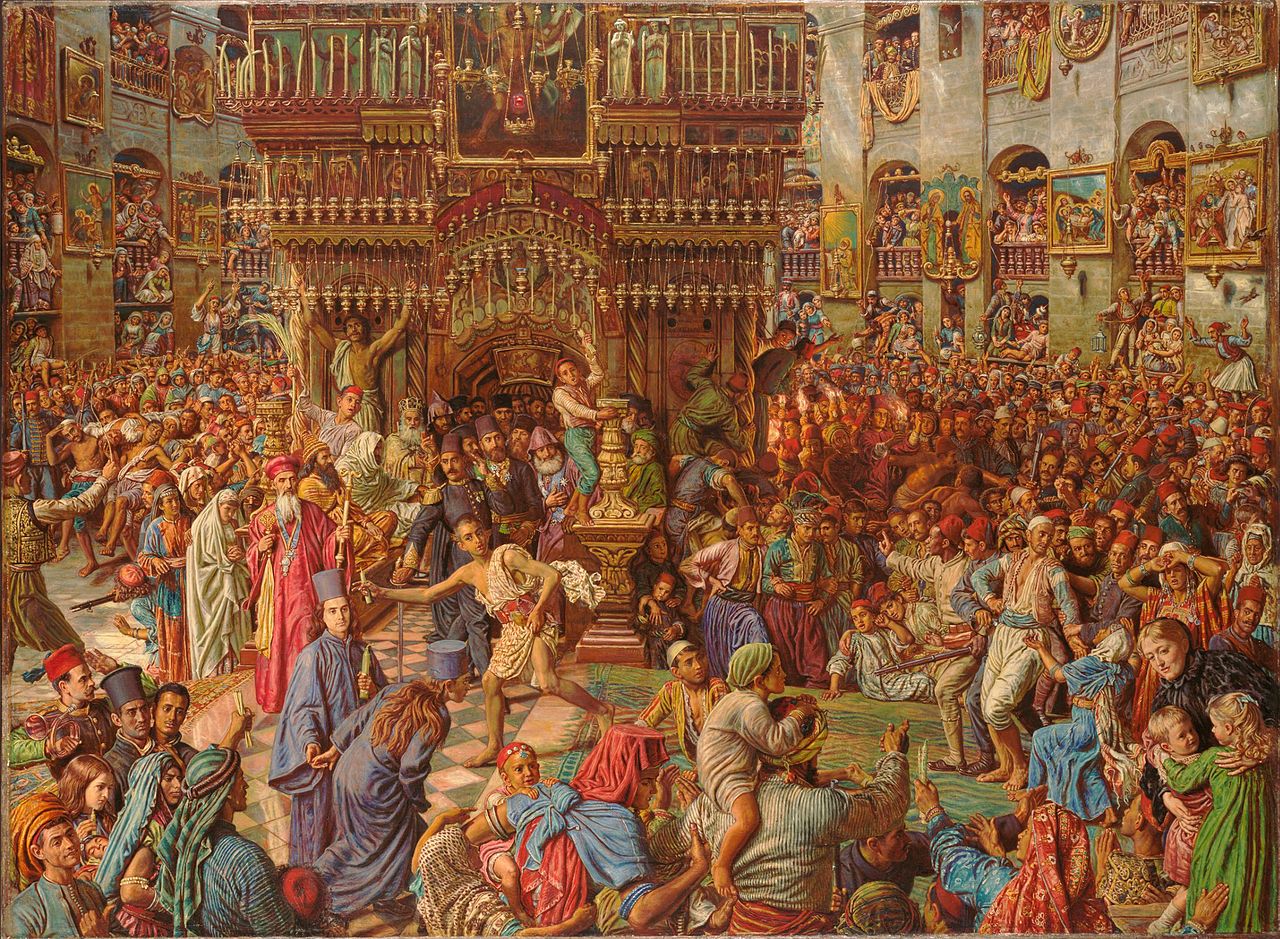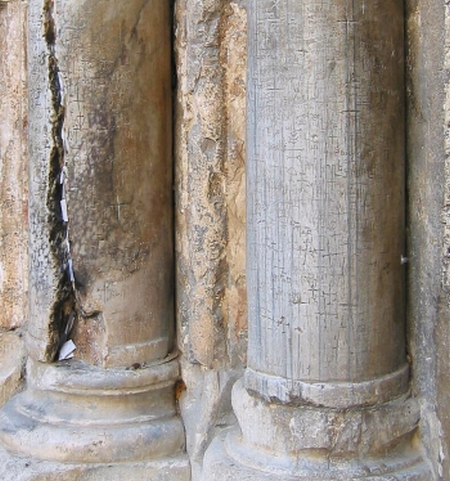Good day, our dear readers! Today I want to speak about a very important, interesting, but really complicated topic: The Holy Fire occurring, every year, at the Church of the Holy Sepulcher in Jerusalem on Great Saturday, the day preceding Orthodox Easter.
But before we start discussing the topic, I want to share with you my deepest thoughts. Recently, I have recalled the ancient fable about one old man who taught his arguing sons a lesson using a bunch of pomegranate twigs. When the brothers held together, like that bunch, they were invincible, and when each one was alone, the twigs were easily broken.
It is interesting that our generation took a step forward (well, we are very advanced and progressive in everything!). A considerable number of individuals don’t want to be in a bundle with others. Not only that, but many also consciously try to pull their pomegranate twigs as far as possible from others. Moreover, by shouting, using power and intrigues, they prove that his or her twigs are thicker and “cooler” than the rest. Someone applauds these subjects, calling them cool and charismatic (“the strongest wins in the natural selection!”). Someone, on the contrary, considers himself destitute by these subjects, grumbles in the corner about the machinations of society, and finally goes into his own lifeless “case”. But the majority don’t give a damn about everything if only they are not be touched… “Each is in himself and by himself” became the motto of the 21st century. Maybe this is the reason why people feel so insecure and can be easily broken like twigs?
At all times in the history of mankind, Belief has been the most powerful uniting force. There is a belief in kindness, light, love, honesty, openness, beauty, mercy, and a happy future. Believers call God’s qualities, and atheists call it conscience. Actually, everyone is free to name the concept of “Goodness” as he or she wants. Therefore, the fact that the Holy Fire feast unselfishly unites millions of people, gives these people hope, solace, joy, and faith in the future is already a great gift for all mankind. Is it because this gift comes to us through a specific group of people, the rest of humanity must ignore this explosion of sincere happiness, love, and hope? How many people in the world do not leave the TV or computers, waiting with bated breath when a bright light comes on in the Tomb?! How many “Hurray!” cries are spread with sincere human happiness to all relatives, friends, neighbors, and even complete strangers who have accidentally moved around?! In fact, what difference does it make to call the Holy Fire a “miracle”, “sincere joy”, or “placebo effect”, if a wave of happiness born by it ultimately envelops all good people: Christians, Muslims, Jews, atheists, and skeptics; all-all-all, indiscriminately on religious, sexual, professional or other backgrounds… Wraps and unites! Isn’t that the most important thing? Isn’t that a miracle? Developing this idea: is it not the same miracle as in lighting candles during Jewish Hanukkah, in the climbing on Mount Arafat, and going around the Kaaba seven times during the Hajj? In the clinking of champagne glasses and fireworks on New Year’s Eve? In a good art exhibition or the Olympics? This is a personal positive that spreads and ultimately connects us all.

Now let’s go back to the topic of our article today. Numerous books have been written and films have been made about the Holy Fire, one of the main events in the Orthodox world. A few years ago, I found the “Holy Fire” book by the Greek architect and historian Haris K. Skarlakidis. The book is primarily interesting for its very good selection and analysis of 45 pieces of evidence of the Holy Fire ceremonies by theologians, historians, philosophers, and travelers from the 4th century till modern times. I personally liked that the author quoted not only Christian (including Catholic) historians, but also Persian and Arab scholars.
A particular interest was the evidence related to the Holy Fire ceremony that was in 1579. Why? Please have a little patience!
According to written sources, on Great Saturday of 1579, Ottoman Turkish authorities forbade Orthodox believers to enter the Church of the Holy Sepulcher. Numerous believers remained in the courtyard of the temple throughout the day and even after sunset. The Greek Patriarch Sophronius IV of Jerusalem aimed to perform the ritual, but the authorities deprived him of his legal right. The Patriarch prayed for a long time, standing to the left of the temple’s entrance, next to one of the columns. Then suddenly, when night had already come, the column cracked, and light appeared from the column’s interior. The Patriarch immediately lit his candle and gave the light to the next standing believers. Within minutes, the fire spread among the believers, and the courtyard of the temple lit up. Discouraged by this spectacle Turkish guards opened the gates of the Church, and many believers, led by the Patriarch, solemnly proceeded to the Holy Sepulcher.
This story, with slight variations, is described in many ancient guides to the holy places of Jerusalem. The oldest description was included in the “Guide to the Holy Places of Hieromonk Ananias” manuscript dated 1608 AD (it is currently kept in the Munich Library. Monacensis Graec. 346). Since this record was made 29 years after the event, it is quite possible that Ananias himself could collect testimonies from the participants in that memorable event. Later this story was described in detail by Archimandrite Simeon in his Guide to the Holy City of Jerusalem (Vienna, 1749), and by Moldavian monk Parthenius (1845). By the way, Parfeny suggested that the reason for the column dissection was lightning, however, he noted that after the lightning strike and the fire appearance, the Patriarch personally lit candles and handed over the fire to believers. We should point out this important fact: despite the fact that the patriarch was in centimeters from the epicenter of the cataclysm, he was not hurt and continued the priesthood.
Summarizing the story, a fire or an electric charge (of unknown origin) passed through a column around 440 years ago, leaving a mark in a form of a singed crack, without any known damage for the presented people. Well, this is at least amazing and intriguing!
Skarlakidis quoted the professional conclusions of two famous physicists, Prof. E.M. Morozov and Prof. G.A. Papadopoulos, both big authorities in the field of fracture mechanics. Prof. Morozov, according to Skarlakidis, came to an unequivocal conclusion that a crack could appear only as a result of a powerful electric discharge. Prof. Papadopoulos claims (Skarlakidis quotes their personal e-mail correspondence) that the crack could appear as a result of an electric discharge and a seismic shock that occurred simultaneously (I emphasize this one!). For me, a non-professional, this event really looks like a miracle. Therefore, I am pleased to contact our expert for clarification. Moreover, he, more than once, had the opportunity to inspect the crack personally.

Dmitri Burshtyn: Theoretically, it is possible. If, for example, the stones from which the temple is built contain micro-crystals of quartz (the so-called quartz-rich rocks), then the vibration of the walls of the temple caused by an earthquake, could generate a significant electric charge, due to the piezoelectric effect (which is very strong in quartz). The piezoelectric effect is an accumulation of electric charge on a certain kind of crystals in response to applied mechanical stress. This could cause a discharge that looks like local lightning. Ordinary lightning is many kilometers long and is caused by a potential difference of hundreds of millions of volts. Also due to the extremely high temperature of the lightning channel (about 30,000 degrees), it causes an “explosion” that strikes everything around several meters away from the lightning channel. But in the case of such “local” lightning caused by the electrification of the walls of the temple, the potential difference is much smaller, and while the electric discharge can crack and melt stones locally, it does not have such devastating force as ordinary lightning (the simplest analogy would be a couple of meters long electric arc).
By the way, the same piezoelectric effect in the walls of the temple can explain the lighting of the oil lamp in usual conditions: when the church is full of prayers, which praying and singing in unison, acoustic vibrations can match the resonant frequency of the walls of the temple, and cause walls vibration with sufficient amplitude to generate piezoelectricity. The generated electric charge accumulates on the walls and, at some point, causes micro discharges that can light the lamp.
All this can explain the fire ignition mechanism, but not the fact that when the believers were not allowed to pray in the temple, there was an earthquake that helped to light the fire.
Administrator’s word: Thank you very much. Your opinion is clear. And we wait for the comments of our readers.
Featured image: Israel Police / CC BY-SA (https://creativecommons.org/licenses/by-sa/3.0)
